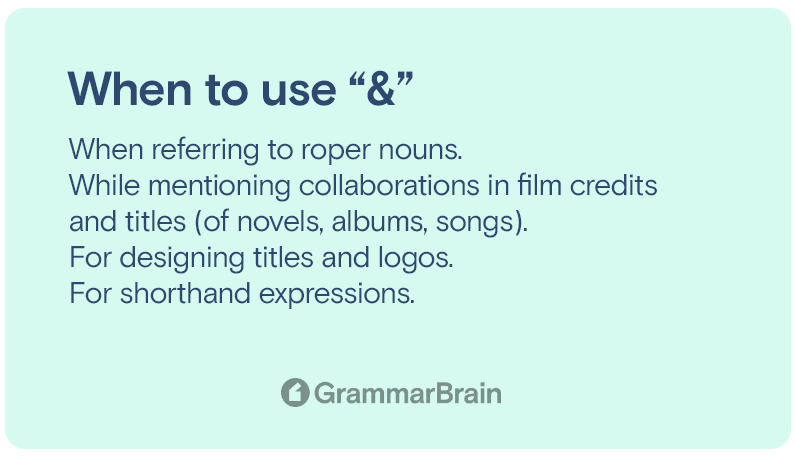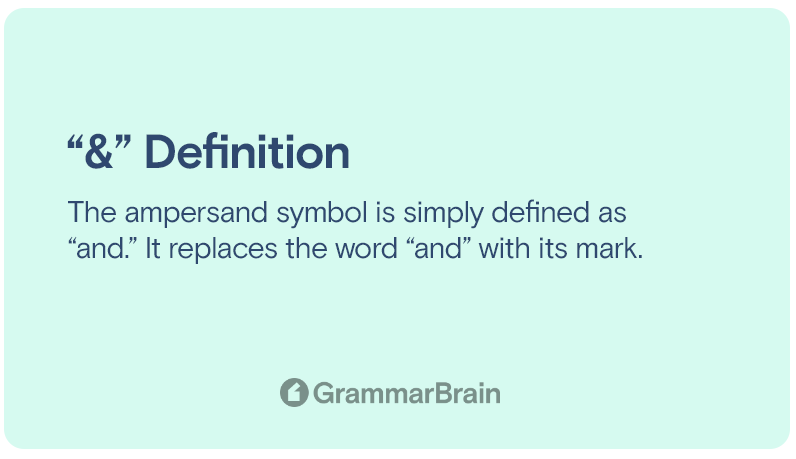When should you use the ampersand symbol? A unique feature of the English language is the ampersand or ‘&’ symbol. This is an ancient symbol, but most of us are still unsure when to use the ampersand. You might wonder whether you can use the ampersand instead of ‘and’ in academic or official writing.
Today we will try to understand the purpose of this punctuation mark and the contexts for when using the ampersand is allowed or permissible.

What is an ampersand?
As Dictionary.com puts it, the symbol of an ampersand, i.e. ‘&’ stands for the word ‘and’. The character represents the word ‘and.’
The ampersand is a typographical symbol. A typographical symbol is a character that is not a punctuation mark but is used in writing, mainly in informal writing. ‘&’ is used as a substitution for the word ‘and’ and also read aloud as ‘and.’
| Mark | Definition |
| & (ampersand) | And |
| Ampersand | the sign & (standing for and, as in Smith & Co., or the Latin et, as in &c ). |
Origin and meaning of the ampersand
As Grammarist tells us, the ampersand symbol has been in use since the Roman empire. Its first appearance was in the first century in Old Roman Cursive.
Originally, the ampersand was a ligature, which means it is a character combining two letters. It is a combination of the ‘e’ and ’t’, which together form the Latin word ‘et.’ Since ‘et’ means ‘and’, it is widely used instead of ‘and’ in informal writing.
The word ‘ampersand’ has a unique origin. Interestingly, the ‘&’ symbol was once considered to be the 27th letter of the alphabet and is a shortened version of “and per se and.”
It was around then that the mispronunciation of ‘and per se’ or ‘and per se and’ started. And this led to the formation of the word ‘ampersand’. It is a mondegreen. In the 19th century, the ‘&’ mark came to be known as the ampersand symbol.

Which is better – using the ampersand (&) or ‘and’?
Authors, especially business writers, must be aware of when to use the ampersand and the rules of its application.
It is better to use ‘and’ in titles, headings, and regular texts. Some applications where it is better or okay to use the ampersand are:
- When referring to proper nouns.
- While mentioning collaborations in film credits and titles (of novels, albums, songs).
- For designing titles and logos.
- For shorthand expressions.
- When abbreviating ‘et cetera’ as ‘&c’.
- To signify ‘and’ in a list where the word ’and’ or commas are used as separators in a sentence.
- In citations having multiple authors.
- When there are two addresses.
When to use the ampersand in formal writing
As you might have understood, it is better to avoid using the ampersand when writing professionally, i.e., in emails and other business writing. It is acceptable to use ‘&’ in place of ‘and,’ where there is space constraint and signages and titles.
Where to put the ‘&’: Ampersand examples
The following sentences will help you understand when to use the ampersand correctly:
- Stan, Kiara & Lucy went to the mall.
- Johnson & Johnson sells great baby products.
- I would love an egg, milk, and a peanut butter & jelly sandwich for breakfast.
- Sending you hugs & kisses bestie!
- She is going to Tiffany & Co. to buy new jewelry.
Conclusion
The rules given above are all unwritten rules about the use of the ampersand. But to the question, ‘when to use the ampersand?’, the best answer is never. It is best to avoid it altogether if you can. It makes the writer look careless and less professional, except while using it in shorthand terms and proper names. You can use the ampersand in place of ‘and’ in informal writing, like handwritten notes and emails to loved ones.
More punctuation marks (all 26 marks)
| Symbol | Name | Example |
| . | Period | I got this at the fair. |
| ? | Question mark | How many trucks does he have? |
| ! | Exclamation point | Wow! You’re a great rider. |
| , | Comma | I like the movie, but the color grading is odd to me. |
| : | Colon | Here are some fun ideas for the party: trivia questions, shuffle board, and more. |
| ; | Semicolon | I’ll visit you once I’m done with work; that’s a promise. |
| – | Hyphen | I have double-life situations. |
| – | En dash | How long is a China-Russia fight? |
| — | Em dash | The dog—and I’m afraid of four-legged animals—was so adorable. |
| ( ) | Parentheses | His favorite team (Chicago Bulls) has a chance to win the title. |
| [ ] | Square brackets | The AP writer said “[head] of baseball operations was disappointed.” |
| { } | Curly brackets | The colors {orange, green, lilac, blue} are for the garage. |
| < > | Angle brackets | |
| “ ” | Quotation marks | Bryan called it a “great situation.” |
| ‘ | Apostrophe | Some of Susan’s clothes are missing. |
| / | Slash or Virgule | I’m ordering food/dessert/more. |
| … | Ellipses | According to the school the “president… was disappointed.” |
| * | Asterisk | *Data from The Economist |
| & | Ampersand | Tiffany & Co. |
| • | Bullet point | • Simple • Great • Awesome |
| # | Pound symbol | #1 selling |
| ~ | Tilde | Bryan owns ~10 pairs of shoes. |
| \ | Backslash | |
| @ | At symbol | [email protected] |
| ^ | Caret symbol | 3^3 = 27 |
| | | Pipe symbol |
FAQs
Is the ampersand acceptable to use in formal writing?
Yes, the ampersand is acceptable to use in both formal and informal writing.
When should I use the ampersand rather than “and?”
Most commonly, it will get used when shortening a long list of items that are related.
How is the ampersand “&” used in APA Style?
In APA style, the ampersand is used when using in-text citations (For example: Smith & Jones, 2005). In the list of references, an ampersand precedes the last author’s name when there is more than one author.
What does the ampersand character do?
The ampersand character denotes in many logics, an operator connecting two propositions
Inside this article
Fact checked:
Content is rigorously reviewed by a team of qualified and experienced fact checkers. Fact checkers review articles for factual accuracy, relevance, and timeliness. Learn more.
Core lessons
Glossary
- Abstract Noun
- Accusative Case
- Anecdote
- Antonym
- Active Sentence
- Adverb
- Adjective
- Allegory
- Alliteration
- Adjective Clause
- Adjective Phrase
- Ampersand
- Anastrophe
- Adverbial Clause
- Appositive Phrase
- Clause
- Compound Adjective
- Complex Sentence
- Compound Words
- Compound Predicate
- Common Noun
- Comparative Adjective
- Comparative and Superlative
- Compound Noun
- Compound Subject
- Compound Sentence
- Copular Verb
- Collective Noun
- Colloquialism
- Conciseness
- Consonance
- Conditional
- Concrete Noun
- Conjunction
- Conjugation
- Conditional Sentence
- Comma Splice
- Correlative Conjunction
- Coordinating Conjunction
- Coordinate Adjective
- Cumulative Adjective
- Dative Case
- Determiner
- Declarative Sentence
- Declarative Statement
- Direct Object Pronoun
- Direct Object
- Diction
- Diphthong
- Dangling Modifier
- Demonstrative Pronoun
- Demonstrative Adjective
- Direct Characterization
- Definite Article
- Doublespeak
- False Dilemma Fallacy
- Future Perfect Progressive
- Future Simple
- Future Perfect Continuous
- Future Perfect
- First Conditional
- Irregular Adjective
- Irregular Verb
- Imperative Sentence
- Indefinite Article
- Intransitive Verb
- Introductory Phrase
- Indefinite Pronoun
- Indirect Characterization
- Interrogative Sentence
- Intensive Pronoun
- Inanimate Object
- Indefinite Tense
- Infinitive Phrase
- Interjection
- Intensifier
- Infinitive
- Indicative Mood
- Participle
- Parallelism
- Prepositional Phrase
- Past Simple Tense
- Past Continuous Tense
- Past Perfect Tense
- Past Progressive Tense
- Present Simple Tense
- Present Perfect Tense
- Personal Pronoun
- Personification
- Persuasive Writing
- Parallel Structure
- Phrasal Verb
- Predicate Adjective
- Predicate Nominative
- Phonetic Language
- Plural Noun
- Punctuation
- Punctuation Marks
- Preposition
- Preposition of Place
- Parts of Speech
- Possessive Adjective
- Possessive Determiner
- Possessive Case
- Possessive Noun
- Proper Adjective
- Proper Noun
- Present Participle
- Prefix
- Predicate



